– BLOG UPDATED 9/25/17
Some pool owners have a misconception that throwing shock into the pool and owning a salt chlorine generator forfeits you from having to deal with chemicals again. Unfortunately, this is not the case. Yes, you will worry less about certain chemicals, but the importance of a well-balanced pool remains.
Before attempting to operate your new saltwater chlorine generator, there are a few steps every pool owner should follow to ensure the best use of your system. Did you know that before you even operate your unit, salt must be added to your pool? Actually, you should evaluate your pool’s water chemistry as a whole. A properly balanced pool is not only essential to the performance of your chlorine generator but also important in protecting your pool equipment and swimmers from other potentially dangerous situations.
To help out new salt chlorine generator owners, we’ve created a chemical quick start guide before operating your chlorine generator.
STEP 1: Calculate Pool Volume

One of the first things you should become very familiar with is how many gallons of water your pool holds. This information is used frequently when trying to size your equipment correctly for your pool and when you’re adjusting chemical levels.
You can determine the number of gallons of water in your pool by using the formulas to the left. For non-standard shaped pools, it may be easier to break your pool into sections to calculate. Then, simply add all the sections for a total amount.
STEP 2: Adjust Your Salt Levels
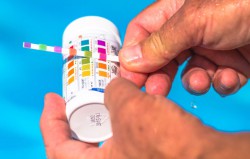 Before you do any adjusting to your salt levels, you first have to determine how much salt is currently in the water. We offer various pool water testing equipment on our site that you can purchase that will assist you in testing your water. The recommended salt levels are between 2700-3400 parts per million (ppm), with the ideal level being at 3200 ppm. (Some systems may require a higher minimum level. Check your manual for specifics)
Before you do any adjusting to your salt levels, you first have to determine how much salt is currently in the water. We offer various pool water testing equipment on our site that you can purchase that will assist you in testing your water. The recommended salt levels are between 2700-3400 parts per million (ppm), with the ideal level being at 3200 ppm. (Some systems may require a higher minimum level. Check your manual for specifics)
After testing the salt, determine how much you need to add until you reach the 3200 ppm mark.
Salt chlorine generators may indicate low salt sometimes and it prompts pool owners to add more salt. Then, once they test their levels, their salt PPM is extremely high. The reason this happens is due to a failure in the salt cell. Failure in your salt cell can trigger false readings. To ensure proper levels, always, always, always test your pool water. A simple water test can tell you where your pool water stands as a whole allowing you to make adjustments accordingly.

 STEP 3: Adjust Cyanuric Acid
STEP 3: Adjust Cyanuric Acid
Cyanuric acid (stabilizer) is essential to the performance of your chlorine generator system. Cyanuric acid is a mild acid that helps prevent the breakdown of chlorine due to the sun’s ultraviolet rays. If you live in a region where the sun is a frequent visitor, you may want to pay close attention to these levels. For cyanuric acid, the ideal level for outdoor pools is 60-80 ppm, while for covered pools it is 20-40 ppm. The ppm for indoor pools should be 0, as there is no need to add stabilizer to a pool not affected by the sun.
STEP 4: Adjust Free Chlorine
You should test and monitor your available free chlorine levels on a weekly basis. Free chlorine levels should remain between 1-3 ppm. You can lower your free chlorine by reducing the output setting on your generator. Also, consider increasing the pump runtime if you cannot maintain a high enough FC.
STEP 5: Adjust Total Alkalinity
The total alkalinity (TA) measures the total alkaline substance in your pool water. Alkalinity is the name given to the capacity of an aqueous solution to neutralize an acid. The ideal level for TA is 60-80 ppm. The results of improper TA levels range from corrosion of metal pool parts, staining of your pool, burning and itchy eyes, cloudy water, and reduced chlorine efficiency. You can increase the pool‘s TA using sodium bicarbonate (baking soda) and decrease the TA using muriatic acid
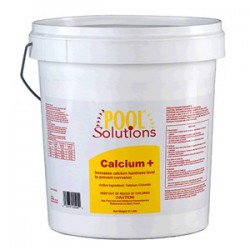 STEP 6: Adjust Calcium Hardness
STEP 6: Adjust Calcium Hardness
Calcium hardness is the measurement of the total amount of minerals that are found in your pool’s water. If you’ve heard the phrase ‘hard water’, it is simply referring to a high mineral content. Ideally, your total hardness should fall between 200-400 ppm, however, it may vary if you have a fiberglass or vinyl pool. Too much calcium hardness causes scaling in your pool and too little causes your pool water to become corrosive. While drinking ‘hard’ water is not necessarily harmful to one’s health, it can pose serious problems to your pool equipment.
- 50-300 ppm for vinyl (Do Not Add)
- 220-320 ppm for fiberglass
- 350-450 ppm for plaster
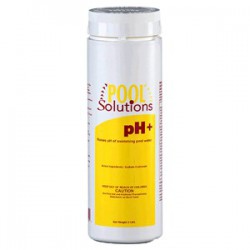 STEP 7: Adjust pH
STEP 7: Adjust pH
pH is the measure of how acid/alkaline the pool water is. Pools with a pH of less than 7 are considered acidic. The ideal pH level for your pool is 7.2-7.8. If your pH is too low, the water can become corrosive to your pool equipment. If your pH is too high, the chlorine becomes much less effective for sanitation. Pools with salt systems tend to have a higher pH level. Because of this, you will probably be adding a little more acid to your pool than most traditional chlorine pools. If you don’t keep your pH levels in check and they continue to rise, calcium scaling along your tile walls begin to develop. Additionally, calcium scaling also affects your saltwater cell, thus shortening the overall lifespan of the cell itself.
Water chemistry for saltwater pools slightly varies from traditional chlorine pools. If you need advice on balancing your saltwater pool, post your results in the comments section and we’ll do our best to help you get your pool balanced.

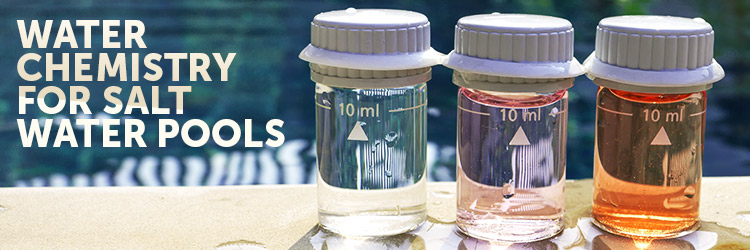
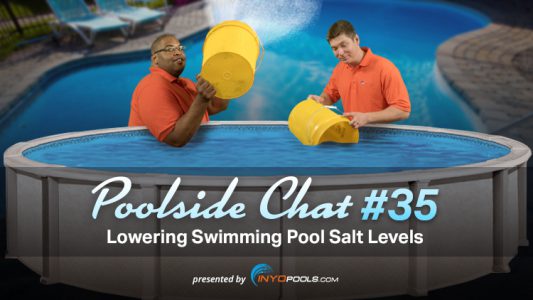
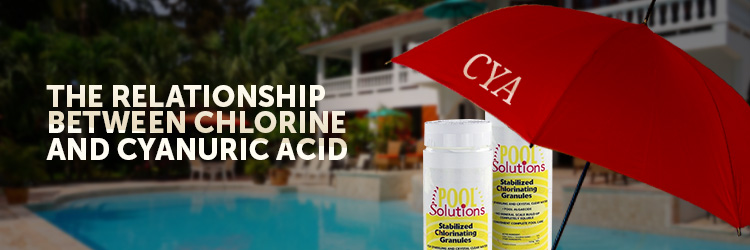
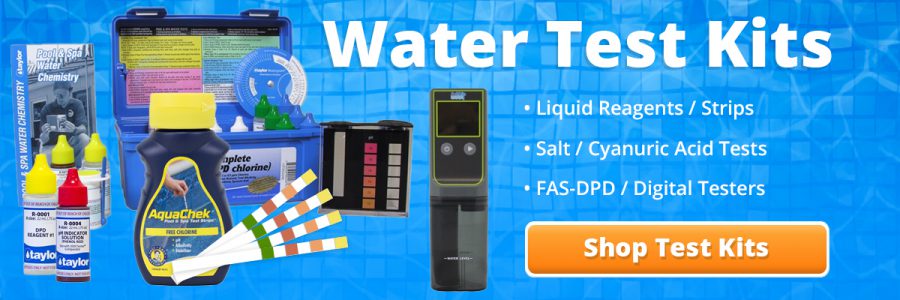
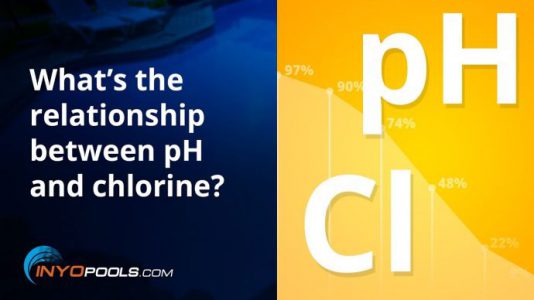






We’ve had saltwater system for three months. Pool is clear, salt meter is at 28-29. We have a T-15 T cell and the light is blinking to indicate a need to clean it. I’ve cleaned it but not with muriatic acid (still blinking). Ph and alkalinity are at high end. All other readings are good. This is a Hayward system.
Then I would let muriatic acid have a crack at it. I’m not sure what you are washing it with but there is a reason the standard method uses MA, it works.
I also want to mention that the water is perfectly clear, always. I noticed that my niece’s hair was super tangled after swimming and that’s why I tested the water. I have a 5 way test kit that I use and the test strips. My chlorine and free chlorine are low and so was the stabilizer. I added stabilizer 2 days ago but I’m not sure what I should do next. Do I shock it or just let the salt cell do it’s job? I clean the cell every couple of weeks because of the calcium build-up.
How is everyone getting exact measurements? I have an 18′ x 52″ intex pool with a saltwater system. We have hard water in my area and I’ve added hardness reducers for that. We also always have high ph and alkalinity. I’ve added muriatic acid and now it’s too low. I had done an acid demand test and added the amount required. I’ve googled this so many times but I don’t get the answers that are working. Please help
I have a few month old pebble tech salt water pool. The test strips show Alkalinity low and CYA low.
A digital tester reveals the following:
FCL 2.14
TCL 2.14
PH 7.7
ALY 64
CH 235
CYA 38
What if anything do you suggest?
Thank you
Salt is 3200
This digital tester, is it one you purchased or did you get it tested from a local pool store? I always lean towards pool store results being the most accurate. I especially trust the pool store tests more in the case of a conflict in results such as this. Test strips can be fouled, and digital home test kits can be a great tool but finicky. If you haven’t already gotten a pool store water test, that should be your next step.
Also our stabilizer levels are perfect
We have a 12×24 oval above ground salt water pool. Salt level is 3300. Our ph is high. Alkalinity high and free chlorine is 0. Just cleaned out the salt cell as it was corroded with deposit after only 2 months. Cannot get the alkalinity or chlorine at the right levels. What are we doing wrong? How often should we need to shock a salt water pool?
Salt pools, naturally run a high pH. But we will start with the chlorine issue first. Units like the Aquarite usually need a cleaning every 500 operational hours. So, if you have you chlorine set to run 50 percent of the time, and you run your pump 24 hours a day, then that is 12 operational hours per day put on the cell. hours can rack up quick, depending on how you run the cell. The cell was likely lagging because it was so dirty. To help figure out how much chemical you need to add for each category, try this Pool Math Calculator
A salt shouldoft need to be shocked but maybe once or twice, outside od opening and closings. The chlorinator should be able to handle anything you throw at it. Shock should only be a tool to help give the chlorinator a boost if you need to add fresh water or after a large gathering of swimmers.
Hi, I am struggling with getting the pH down. These are my numbers:
Cl- 2
pH-8.5
TA-180
CY-30
Calcium-300
Salt-3130 Pentair chlorinator runs 12 hours at 60%
Any suggestions are appreciated!
Thank you,
Brad
Salt pools run at a higher pH, so battling that is going to be a constant. There isn’t much of a tip for this, you would need to add enough pH Down or soda ash to bring it into check.
A helpful tool in figuring out how much of each chemical or balancer needed for your pool is PoolMath Calculator.
Your alkalinity is too high. It will cause the PH to be constantly higher
Purchase pentair intellichem it would monitor and add acid and keep your ph in check fantastic product
My pool is cloudy and am having a problem getting it to clear up. I had my water tested and here are the results. Help please!
PH 7.7
FC 1.7
TA 82
Total Hardness 70
Salt Level 26
Your hardness reading is very low, it could be the cause of cloudiness. When your calcium hardness is that low, the water begins to leach from the pool surface. The calcium hardness should be around 200 – 400 ppm.
have a 27000 gallon salt pool. Salt generator registers 3200. Electronic Aqua check strips read:
cl-0.0
ph-7.3
akl-130
How can I raise my chlorine level?
You’re missing a really important value, the stabilizer, CYA levels. Can you post that as well? That will help to figure out if your CYA levels are super high, which can harm the effectiveness of your chlorine?
But if you want to raise your chlorine quick, use shock, liquid chlorine, or bleach.
Hi Matthew, I’m replastering my pool. Do you have a start up for plaster or is it the same procedure as the pebble tel start up ?
If you are replastering your pool, you need to hold off converting to saltwater for 60-90 days. Ask your plastering company for their recommendation to be sure though. Plaster needs time to cure. If you convert to salt too early after plastering, you are throwing a lot of money down the drain.
I have a 20 x 45 pool. It is only 7 ft deep instead of 8, so I think about 37000 gallons. I take care of it myself. Salt generator, and de filter. We had electric heater but just added a propane unit. I am told the pipes will corrode easily if ph is low.
I don’t want to depend on the colored dipsticks. Can you recommend a step up for alkalinity, and ph testing. ( my generator shows chlorine levels)
There are electronic testers, but they still use test strips – Aqua Chek Trutest Digital Reader – NP207
Your generator model may have an add-on accessory like a Sense and Dispense system that can read pH and alkalinity snd then disperse the necessary amount of chemicals automatically. What model of salt system do you own?
Hey Matt, thanks for the guide, it is a good simple breakdown. I have a salt water pool in N. FL that gets full day sun. My FC is always maxed out on the local store test of 5ppm, could be higher. Due to this I turned my salt cell output from 70% to 50% and let my stablizer fall to 30-40ppm, hoping to reduce FC. Even at 50% output for week with my salt at 3200ppm my FC is above 5ppm, what can I do to get this in check, should I lower the output more espically going into summer? Also my PH is always testing at 8 so we add a quarter gallon muratic acid weekly. All the sudden my test shows a PH is at 7.6 and my Total Alkalanity is at 75ppm, every other test it was at 100ppm. Is my total alkalanity a diret product of my PH, meaning when we try to lower PH with muratic acid it is also lowering total alkalinity? If so why can’t I get my PH under 8 and my total Alkalnity withhin normal range at same time? Am I splitting hairs? How do I get this thing balanced.
Lower the chlorine output to 30 or 40 until the FC gets back in check. The excess chlorine will eventually get used up and you’ll see the FC drop.When it gets back to a desirable level then you can go back up to 50 percent. I don’t know the size of your pool or the generator. But for an example, if you have a 40K salt generator and you only have a 15K gallon pool you are overdosing the pool. When the hotter days come you can up the dose as necessary.
Muriatic acid will bring down both pH and alkalinity. Saltwater pools have a naturally higher pH, that is why you always have to keep an eye on it.
The reason your PH is always going up is from the salt cell making bubbles as it turns salt into chlorine. This is also called aeration which will only effect the PH to go up but not your Total Alkalinity. So what you will find is that as you have to add Muriatic acid to lower your PH it will also lower your Total Alkalinity and you will have to add Bi Carb. which is baking soda to raise your Total Alkalinity back up to standard all the time. Get used to it as this is how salt water systems work when you want to make your own chlorine. A salt water pool makes a pool’s PH & TA a roller coaster going up & down compared to a normal chlorine pool which has liquid chlorine added as needed as they stay more stable as they don’t have aeration constantly going into them.
Lowering & adjusting the run time along with the cell output to meet your pools chlorine needs is the best thing you can do as to many people turn their cells up to high & run them to long.
I would challenge the assertion that you have to get used constantly adding chemicals to a salt water pool. After opening ours in the spring and spending a few days getting the chemistry adjusted (usually amounts to adding salt lost through pumping out water over the winter and a minor ph / alkalinity tweak) we rarely have to do anything to our pool to keep ph around 7.5 and TA around 100.
Just got my chlorinator running again. Had to change out the flow switch. Pool was green. Pool company told me in the mean time, add a double dose of Bioguard banish and 2 more bags of burnout 73. Green is gone but cloudy enough to only see about 2 feet down. Just tested the water and chlorine is off the chart (above 5) and pH is likewise off the chart high ( greater than 8.2). How do I get this down? Bleed and feed?
Use pH reducer or muriatic acid to lower the pH to the correct range. Then use a clarifier or flocculant to get rid of the cloudiness (the dead algae.)
The chlorine will burn off, so that is not much of a concern.
I have vinyl salt water pool (around 75M3) with a Astralpool Sel Clear 95 chlorinator. Also I have a cover over the pool during winter. In the summer when the cover is opened I adjust the chlorinator to 90% of its capacity but I suffer from dropping PH levels. I have tried everything but I can’t find a solution to prevent the PH dropping. Once dropped I add PH+ to correct the levels and add some chloride tablets (4/5 tablets). That keep it sort of stable but after a day or so, the PH drops again, Check the salt level (5.1pps) but it is all fine.
You have any idea whats wrong? I get so frustrated but perhaps you have some good leads..
Thanks
Ron (from Spain)
That’s a mystery to me because salt pools usually run high in the pH category. But my best guess would be that the added tablets are causing the issue. Tablet chlorine also contains stabilizer which will lower your pH. So you may get your pH where you want it after adding the pH+ but then you add tablets, give them a day to start to dissolve and the stabilizer has a chance to lower the pH again.
If the salt system is working properly it should not require tablets. If you need a quick dose of chlorine, add shock or liquid bleach.
Check your total alkalinity is correct. it will mess up the reading on the PH probe
I just replastered my pool with a pebble tech finish, and installed a salt system. The start up pool guy raised the cyanuric acid level to 100 ppm. The local pool store tested the water and suggested I jshould drain some water out before adding the salt. Your thoughts?
Jerry
How long did you wait after to convert to salt after replastering the pool? Hopefully, it was at least 30 days after the replaster.
Here is the start-up procedure for the Pebbletech.
Charlie,
Is there any information or data to suggest that a by-product of a salt water chlorination is barium? We recently had a comprehensive water analysis conducted on both our home drinking water supply and our salt water pool. While there was no barium detected in the potable water, barium was detected in the outdoor pool. While the barium levels in the pool were well within the federal drinking water standards, we were surprised at this discovery. Thoughts?
Charlie,
Is there any information or data to suggest that a by-product of a salt water chlorination is barium? We recently had a comprehensive water analysis conducted on both our home drinking supply and our salt water pool. While there was no barium detected in the potable water, barium was detected in the outdoor pool. While the barium levels were well within the federal drinking water standards, we were surprised at this discovery. Thoughts?
Charlie,
Great article! Thanks! Is there any information or data to suggest that a by-product of a salt water chlorination is barium? We recently had a comprehensive water analysis conducted on both our home drinking supply and our salt water pool. While there was no barium detected in the potable water, barium was detected in the outdoor pool. While the barium levels were well within the federal drinking water standards, we were surprised at this discovery. Thoughts?
I’ve read this a couple of times, but where is the recommended ppm of Chlorine?
The Free Chlorine level should be 1-3 ppm.
Sorry meant to say my low salt filter light remains on.
My salt water levels are high 3700 for a 16 x 48 pool but my salt water filter light remains on. Thoughts?
The 3700 ppm reading you are getting, is it on a home test kit or from a pool store?
Have you tried cleaning the cell? Also, how old is the cell?
Charlie, this was a very informative and well-written article. Kudos sir!
Thanks,
Bob Cook
Montgomery, TX
I have the intex 16x 48″ pool ultra. It can with the pump salt generator and filter. I am wanting to upgrade the filter because it seems I am always changing it. I cannot ever keep my chemical levels steady. I also have many questions about which chemicals are best to use. I see that there are algecides and shock just for saltwater but my pool company sells me shock that says nothing about being for “saltwater pools”. Are there certain things that need to be for saltwater while others work for all?
There may be “saltwater shocks” on the market, but most pool owners use the standard cal-hypo and it work just fine. If you want to learn about water chemistry, read this guide: Water Chemistry For Saltwater Pools
Electronic NaCl monitors actually measure TDS, so if you have hard water an electronic monitor will not give accurate results – is the same true of measuring salt levels using dip sticks? I want to know the best way to measure my salt levels in my salt pool, in an area where the water has about 470-500 ppm.
You can buy electronic handheld salt testers, or you can take a sample to your local pool store for free tests.
I’m a retired engineer (EE) with a fair amount of process control experience. I know the industrial process & hardware but haven’t found much in the way of information on the hardware and software for monitoring the small scale processes involved in a residential pool. Any information on sources would be appreciated.
To help point you in the right direction, what specific processes are you interested in measuring?
I set up my above ground pool 1 week ago. It holds 14,000 gallons. I added 320# salt, ran filter 24 hours, then chlorinated 8 hours daily. I could never get measurable chlorine levels. I ran boost for 24 hours and now it says low salt. All levels tested are off.
When installing a new salt system, I always like to throw in a bag of shock to give the generator a helping hand. The shock kills anything that may be lingering in your water while allowing the generator a chance to build chlorine levels. By the time the shock has worn off, the chlorinator should have a solid foundation of chlorine to keep your pool happy.